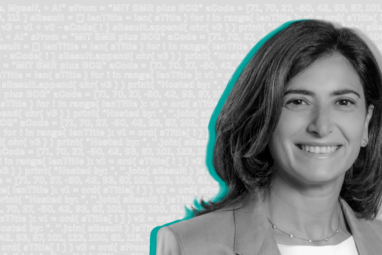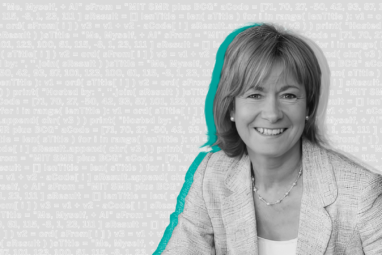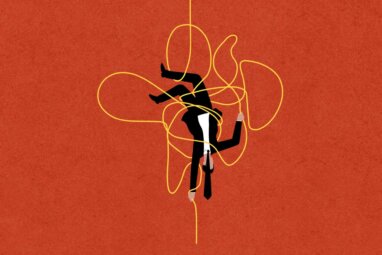The Role of the Board Chair During a Crisis
A company’s long-term survival during a crisis depends on complementary roles, strategic alignment, and chemistry between the chair and CEO.
Topics

Experienced chairpersons know that their success depends on how they walk the tightrope of being too involved or too remote in the company’s strategy execution. Yet when a crisis such as COVID-19 hits and the CEO transforms into Chief Crisis Officer, the chairperson may become increasingly unsure how to strike this balance.
Crisis breeds uncertainty and creates emotionally draining conditions for organizations that require fast decision-making with limited information on the part of leaders. The board’s role to monitor the crisis response of senior executives is crucial and in the interests of all stakeholders, but it also risks creating response delays and bottlenecks. Moreover, the chairperson’s objective to preserve future strategic options for sustainable growth might be difficult to implement when the organization’s short-term survival is on the line. These frictions can increase if the chairperson and CEO have conflicting views on crisis response measures, which in turn can divert the attention of both parties to preserving their image and reputation in the face of the media and key stakeholders — a typical “damned if you do, damned if you don’t” situation.
In light of these dynamics, the interactions between the chairperson and the CEO to establish decision rules, guidelines, expectations, agendas, and communication strategies are an essential and often underestimated success factor for leading organizations through a crisis. We took a closer look at this relationship to explore how experienced chairpersons interpret their role during a crisis, and why success and recovery for companies depend on complementary roles, strategic alignment, and chemistry between the chair and CEO.
The Chairperson and the CEO in the COVID-19 Crisis
Traditionally, the board of directors’ job description is “control” and “advice.” As a control function, each board member ensures that senior executives act in the stakeholders’ interests. The advice function contributes to corporate decision-making via strategic guidance and counseling to executive teams. For both functions, the chair builds the bridge between the board and the senior executive team.
There is no question that this relationship between the chair and the CEO is critical for success, particularly during the current COVID-19 crisis. Monika Ribar, chairwoman at Swiss Federal Railways (SBB), focuses regular interactions with her CEO on the main crisis-related activities and actions implemented. By doing as much as she can to be approachable at any time for her CEO, Ribar says she keeps all means of communication open to help and learn as much as possible about the senior executive team’s approach to fight the crisis. Aware of her increased strategic responsibilities for the company amid a global pandemic, these regular exchanges allow her to be involved and informed early on. Effective chairs understand the role they must play in order to lead and use the board of directors as a highly effective team at the service of the company and its stakeholders.
The chairpersons at other organizations, such as Boston Children’s Hospital (BCH), A.P. Møller – Mærsk A/S, Nestlé, and Siemens AG, are similarly ensuring closer proximity and support for their CEOs. For example, Douglas Berthiaume (chairperson) and Sandra L. Fenwick (CEO) at BCH are strongly aligned about preserving the hospital’s core identity, “Until Every Child Is Well,” as well as the hospital’s mission and values for BCH’s clinical care work and its community engagement. This fundamental alignment is accentuated during crises. For example, during this crisis, Fenwick and Berthiaume worked together in communicating across multiple boundaries — to their boards, donors, and staff. Fenwick says, “Keeping people informed of changing situations and policies, answering an extraordinary range of personal and professional questions, and keeping people focused, healthy, engaged, resilient, and optimistic is key.”
Jim Hagemann Snabe, chairman at Mærsk and Siemens, similarly emphasizes that he collaborates closely with his CEOs to ensure the consistency of the company’s overall strategic direction. This collaboration provides a “catalyst for reinforcing the firm’s purpose and strategic intent,” says Snabe. And as chairman he guides the company “to stay committed toward its strategic direction despite a need for short-term focus and actions.” While all chairs maintain their traditional roles of control and advice during times of crisis, we found that experienced chairpersons double down on aligning with leadership and safeguarding their organization’s identity and mission.
Safeguarding the identity and mission. With any crisis response, companies face the major risk of reacting with shortsighted, routine-based actions rather than creating an overall strategic recovery plan. When crises unfold, CEOs are pressured to take immediate action and communicate a response quickly — even when the full scope and impact of the crisis is not known. Divestments, product eliminations, layoffs, and cost cutting help to ease the pressure for immediate performance improvements. Yet, they risk carving up the organization’s heart and soul when these efforts fail to recognize critical skills, capabilities, experience, and culture so crucial to the organization’s long-term recovery.
This critical point in the response is where the relationship between chairperson and CEO plays a key role. For example, at Boston Children’s Hospital, Fenwick and her board chair’s emphasis on “Until Every Child Is Well” accentuates the organization’s purpose, identity, and culture during the crisis. Such strong commitment to the organization’s identity functions as an overarching crisis vision that guides senior executives when formulating and implementing crisis response strategies. It helps to avoid confusion, aligns the guiding coalition toward one aspirational goal, motivates employees, and ensures various stakeholders’ support during the crisis. This is even more important in a crisis, says Snabe, “as uncertainty during crisis may confuse and require challenging prioritization in harmony with the firm’s purpose and strategic intent.” By aligning crisis communications with the organization’s purpose, the chair and CEO can help channel the organization’s energy and passion toward the most fundamental goal: to preserve the organization’s raison d’être.
In order to maintain this focus on purpose, the leadership team must be able to persevere in their roles despite stress and uncertainty. Resilience during a crisis not only helps leaders to keep a clear head but also allows the company to thrive. However, this is easier said than done. Dealing with negative emotions and anxiety, and thus creating a safe space, has surfaced as a critical component that requires the chair’s active attention during a crisis.
Resolving anxiety. Often, leadership teams are unprepared for the fallout of disasters and crises such as COVID-19, which can bring on stress, discomfort, and other negative emotions. The unique circumstances that each crisis presents also make it difficult for senior executives to apply similar action steps or past routines to cope with the current situation. These psychologically challenging conditions are counterproductive when the team could be instilling confidence in employees. Instead, this instability creates doubt and mistrust when responding to often very emotional stakeholder demands.
In all of the leading companies we’ve worked with, chairpersons focused on actively addressing the emotional and psychological impact on their CEOs. At Nestlé, Paul Bulcke emphasizes that emotions are already high during a crisis, and the chairman should not make the mistake of increasing stress and discomfort. By being approachable, expressing sympathy, and applying a team-oriented approach, the chairs display involvement, understanding, care, and empathy — toward their CEO in particular. They provide psychological support and avoid impaired decision-making driven by negative emotions, uncertainty, and fear.
Actively fostering positive energy functions as a catalyst that can help CEOs to remain rational instead of emotional as well. How a chairperson perceives and reacts to the CEO’s negative emotions is key to steering decision-making toward rational facts rather than emotional disagreements.
Creating a safe space. Because of the mutual dependence on a positive crisis outcome, all chairpersons value a trusting relationship with their senior executives and board members. This trust enables the chairperson to function as a sounding board for the CEO during the crisis. The creation of a safe space characterized by openness and honesty not only helps the chair to maintain a close relationship with the CEO but also allows for timely exchanges, feedback, and alignment on strategic actions before presenting them to the full board.
Safe spaces increase the consensus and decision speed during a crisis. However, they should not be forced upon CEOs, who might interpret them as the chair wanting to micromanage the overall crisis response. Instead, CEOs should be encouraged to make independent decisions and act at their discretion. While trust creates a foundation for CEOs to actively seek feedback and advice, it goes both ways. Violating trust can create a vicious cycle of blame and mistrust, causing serious damage to the organization’s chance for recovery post-crisis. This is detrimental to both the CEO and the chair. Consequently, a trusting relationship with the CEO should be built on mutual support and interest. As SBB’s Ribar says, this “we are both in the same boat” mentality brings the chairperson closer to the CEO. In uncertain times, companies need a united leadership front, and safe spaces allow chairs and CEOs to align their individual interests to fight the crisis together.
The Chair Matters
COVID-19 is an unprecedented crisis that has thrown the global economy into turmoil. Now more than ever is a time for companies to ensure alignment and mutual support from the board, the chair, and the CEO. The board and the chair need to stay disciplined, stick to their roles, stay detached from operations, and concentrate on being a sparring partner for the CEO when needed. Experienced chairs don’t interfere or micromanage. Instead, they help CEOs navigate challenges by providing consistent reminders of the organization’s identity and mission.
Moreover, chairpersons use a mix of proximity, positive reinforcement, and trust to ensure timely information flows and to build understanding for the CEO’s challenges and responsibilities. This combination of encouraging mindfulness of business purpose and using empathy enables chairs to help CEOs harness creativity and passion and psychologically anchor themselves when selecting, evaluating, and implementing short-term crisis responses.
Finally, it’s important that chairpersons remain committed to the organization above all — continuing their mission to challenge decisions, defending the organization’s long-term interests, and being prepared to take the lead when needed. After all, facing a crisis does not mean a board chair is invisible or unconditionally supportive. Just as the CEO needs to seize the day, so too does the chair, who plays an especially important role in the organization’s success and long-term survival. Or, as Nestlé chairperson Bulcke says, during a crisis, the chair feels like a “motorcycle driver that needs to look ahead of the curve, because if you keep looking at only what is just in front of you, your wheels don’t come out of the curve well, and you lose your balance.”








